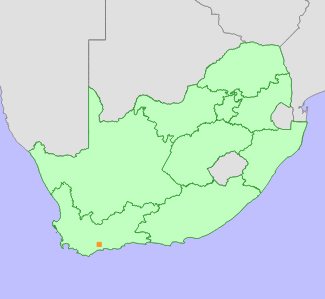|
Scientific Name | Glia pilulosa B.-E.van Wyk |
Higher Classification | Dicotyledons |
Family | APIACEAE |
National Status |
Status and Criteria | Critically Endangered D |
Assessment Date | 2013/11/29 |
Assessor(s) | L. von Staden |
Justification | A single known subpopulation numbering fewer than 20 mature individuals remain in a roadside fragment where it is likely to be subjected to ongoing habitat loss and degradation. |
Distribution |
Endemism | South African endemic |
Provincial distribution | Western Cape |
Range | Bontebokskloof near Swellendam. |
Habitat and Ecology |
Major system | Terrestrial |
Major habitats | Eastern Ruens Shale Renosterveld |
Description | Sandy clay soils in renosterveld. |
Threats |
| More than 80% of this species' habitat, Eastern Rûens Shale Renosterveld, is already irreversibly modified, predominantly for crop cultivation, and this species has undoubtedly lost habitat to crop cultivation in the past. Currently, the only known population occurs in a road reserve where it is unlikely to be impacted by further expansion of crop fields, however, road reserves across South Africa are being degraded by inappropriate vegetation management practices. Most renosterveld species are adapted to fire, but fire is likely to be excluded from small fragments, leading to senescence and degradation of the vegetation. Nearby drainage lines are already invaded by alien invasive plants, and should these be left unmanaged, could spread into this species' habitat. |
Population |
Glia pilulosa is currently known from a single subpopulation of about 14 plants within a roadside fragment surrounded by crop fields. It occurs within Eastern Rûens Shale Renosterveld, a vegetation type classified as Critically Endangered due to more than 80% loss, predominantly due to agricultural expansion. This species was first discovered in 2009, and no surveys have yet been done to locate more subpopulations. However, any other remaining subpopulations are also likely to be small an isolated within remnant renosterveld fragments. It is unlikely that this species was widespread and common in the past, as no historical records exist. The Swellendam area is rich in localized endemics, and this species is likely to have a restricted range. The population trend is not known, but this species is likely to be declining due to ongoing habitat loss, degradation and isolation of small subpopulations.
|
Population trend | Unknown |
Assessment History |
Taxon assessed |
Status and Criteria |
Citation/Red List version | | Glia pilulosa B.-E.van Wyk | CR D | 2014.1 | |
Bibliography |
Van Wyk, B.E., Tilney, P.M. and Magee, A.R. 2010. A revision of the genus Glia (Apiaceae, tribe Heteromorpheae). South African Journal of Botany 76(2):259-271.
|
Citation |
| von Staden, L. 2013. Glia pilulosa B.-E.van Wyk. National Assessment: Red List of South African Plants version 2024.1. Accessed on 2025/11/19 |
 Comment on this assessment
Comment on this assessment


